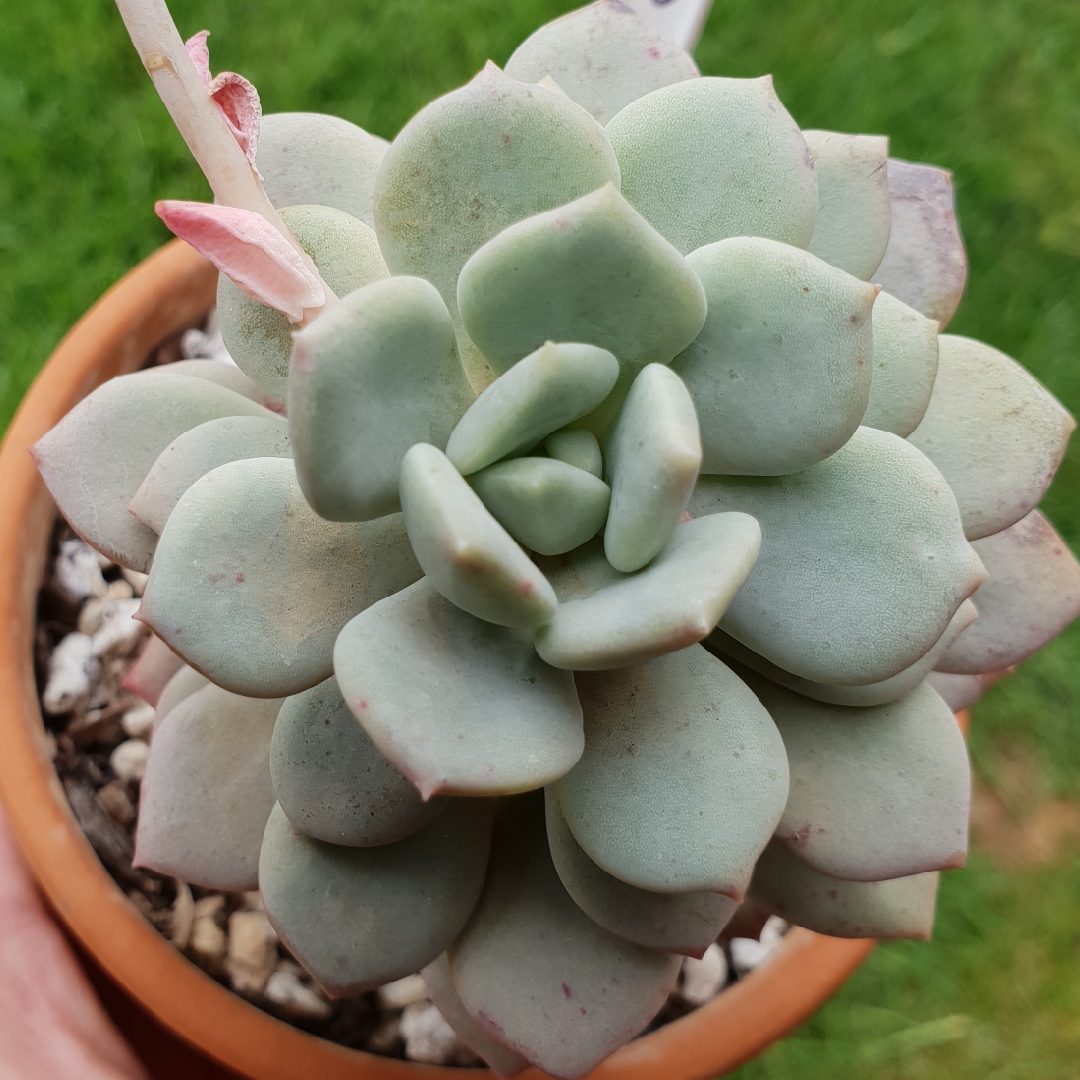
x Pachyveria Calypso
Pachyveria 'Calypso'
Origin and parentage unknown. Named and described by Margrit Bischofberger, published in Sedum Society Newsletter Jan. 2009. Rosette (of a 4 years old plant): ca. 11 cm in dameter, 12 cm high. Leaves numerous, densely packed, stem not visible, biggest leaves 4,5 cm long and 2,3 cm wide in upper half, 0,6 cm thick, glabrous, greenish grey, heavily pruinose, obovate, acuminate with sharp reddish mucro, leaf margins partly reddish; upper side flat, underside slightly rounded, not carinate. Inflorescence : A cincinnus with 3 – 9 flowers, 5 – 6 cm long, bracts on peduncle and between flowers large, 1,4 cm long, 1 cm wide on upper half, 2 mm thick, ventrally flat or slightly concave, dorsally convex, sometimes keeled. Peduncle pinkish, bracts first same colour as leaves, later pinkish red and withering. Pedicels 5 mm long. Flowers : Sepals unequal, longest 1,4 cm (as long as petals), 0,4 – 0,7 cm wide, acuminate, carmine grey, petals 1cm long, 0,6 cm wide, carinate, at apex slightly curved, outside pinkish, inside greenish yellow or orange-yellow, with petal appendages,stamen yellowish, carpel yellowish, style dark red. Normally petal appendages have the same colour as petals, but in this case the upper margins of the appendages are pinkish orange what makes the flowers of this plant very special! In nursery catalogues this plant may be offered sometimes as x Pachyveria ‘Elaine Reinelt' or ‘Debbi Reinelt'. In order to avoid confusion with either x Pachyveria ‘Elaine' ISI 876 or x Graptoveria ‘Debbi' ISI 1087, I have given it a new name. http://www.crassulaceae.ch/de/artikel?akID=147&aaID=2&aiID=C&aID=1267
-
Full sun to partial shade
-
Occasional watering
-
A little frost hardy: 32F (0°C)
-
Free draining and fertile
Common name
Pachyveria 'Calypso'
Latin name
x Pachyveria Calypso
type
Succulent
family
Crassulaceae
ph
5.0 - 7.0 Acid - Neutral
Plant & bloom calendar
-
Best time to plant
full grown dimensions
 0.20 M
0.20 M
0.20 M
0.20 M
x Pachyveria Calypso
Origin and parentage unknown. Named and described by Margrit Bischofberger, published in Sedum Society Newsletter Jan. 2009. Rosette (of a 4 years old plant): ca. 11 cm in dameter, 12 cm high. Leaves numerous, densely packed, stem not visible, biggest leaves 4,5 cm long and 2,3 cm wide in upper half, 0,6 cm thick, glabrous, greenish grey, heavily pruinose, obovate, acuminate with sharp reddish mucro, leaf margins partly reddish; upper side flat, underside slightly rounded, not carinate. Inflorescence : A cincinnus with 3 – 9 flowers, 5 – 6 cm long, bracts on peduncle and between flowers large, 1,4 cm long, 1 cm wide on upper half, 2 mm thick, ventrally flat or slightly concave, dorsally convex, sometimes keeled. Peduncle pinkish, bracts first same colour as leaves, later pinkish red and withering. Pedicels 5 mm long. Flowers : Sepals unequal, longest 1,4 cm (as long as petals), 0,4 – 0,7 cm wide, acuminate, carmine grey, petals 1cm long, 0,6 cm wide, carinate, at apex slightly curved, outside pinkish, inside greenish yellow or orange-yellow, with petal appendages,stamen yellowish, carpel yellowish, style dark red. Normally petal appendages have the same colour as petals, but in this case the upper margins of the appendages are pinkish orange what makes the flowers of this plant very special! In nursery catalogues this plant may be offered sometimes as x Pachyveria ‘Elaine Reinelt' or ‘Debbi Reinelt'. In order to avoid confusion with either x Pachyveria ‘Elaine' ISI 876 or x Graptoveria ‘Debbi' ISI 1087, I have given it a new name. http://www.crassulaceae.ch/de/artikel?akID=147&aaID=2&aiID=C&aID=1267
Planting young plants
From Early Spring TO Early Spring
Prior to planting, work in a 50/50 mix of compost and sand or pumice into the pot or growing site. Plant your 'Little Jewel' no deeper than it was planted in the nursery pot it came in. Provide at least 12 inches of space around the plant to it to sprawl, since Pachyveria plants start out upright, but then spread out along the ground. Mulch around the plant with black pebbles to enhance its appearance.









